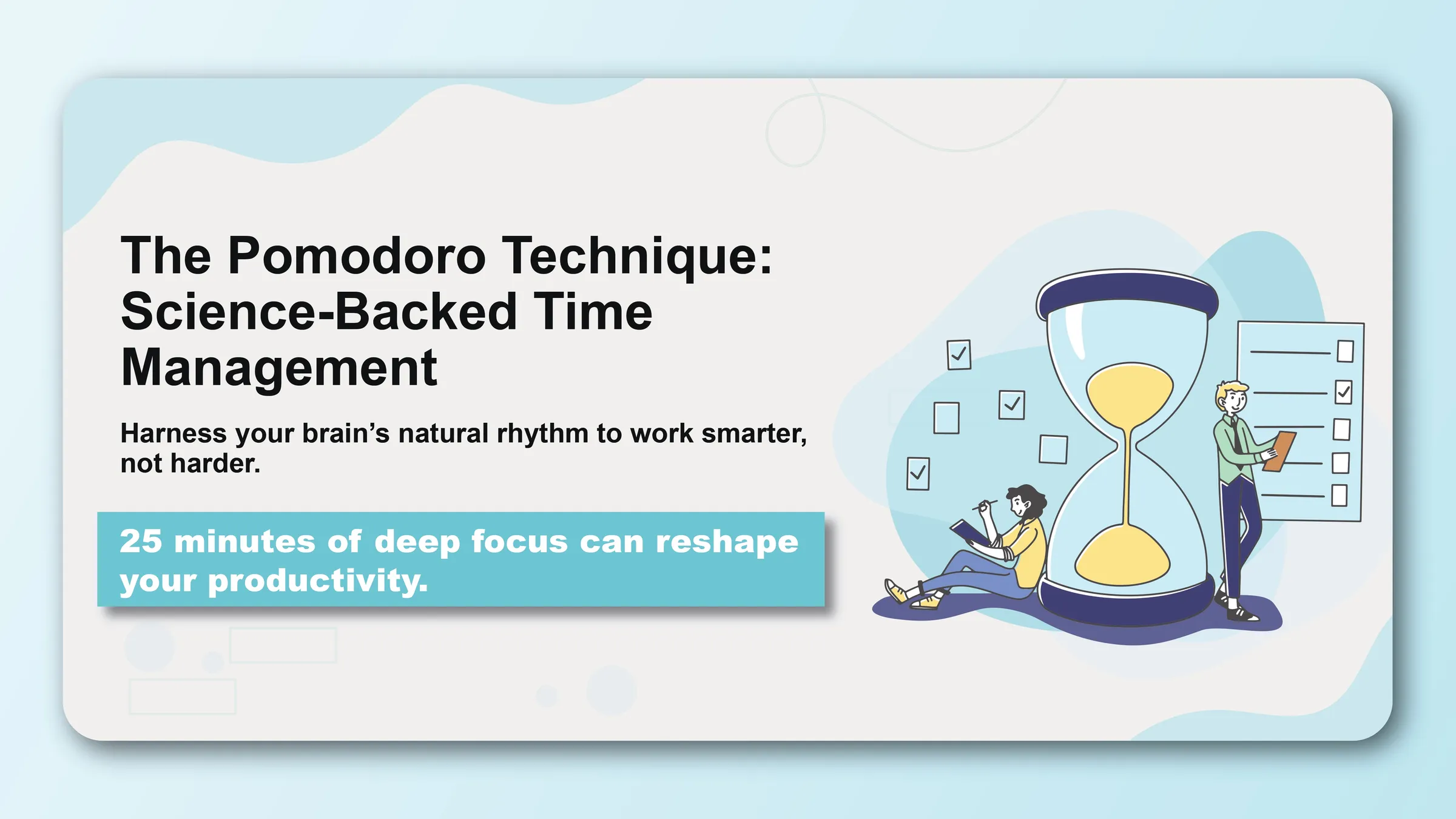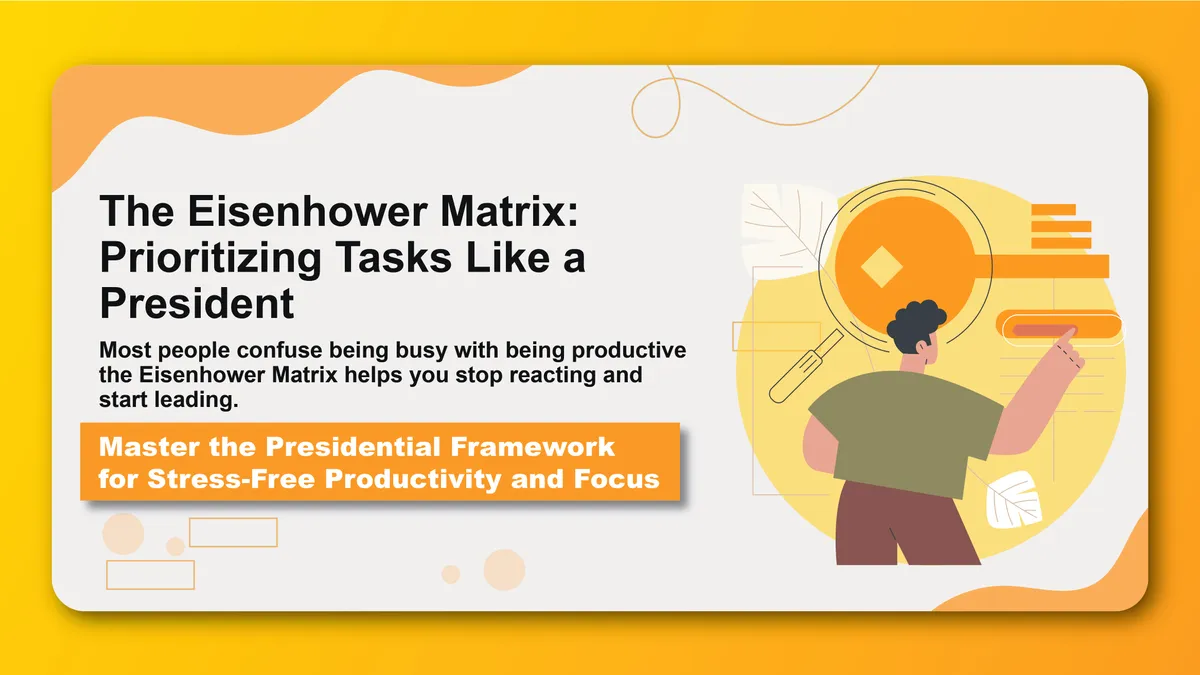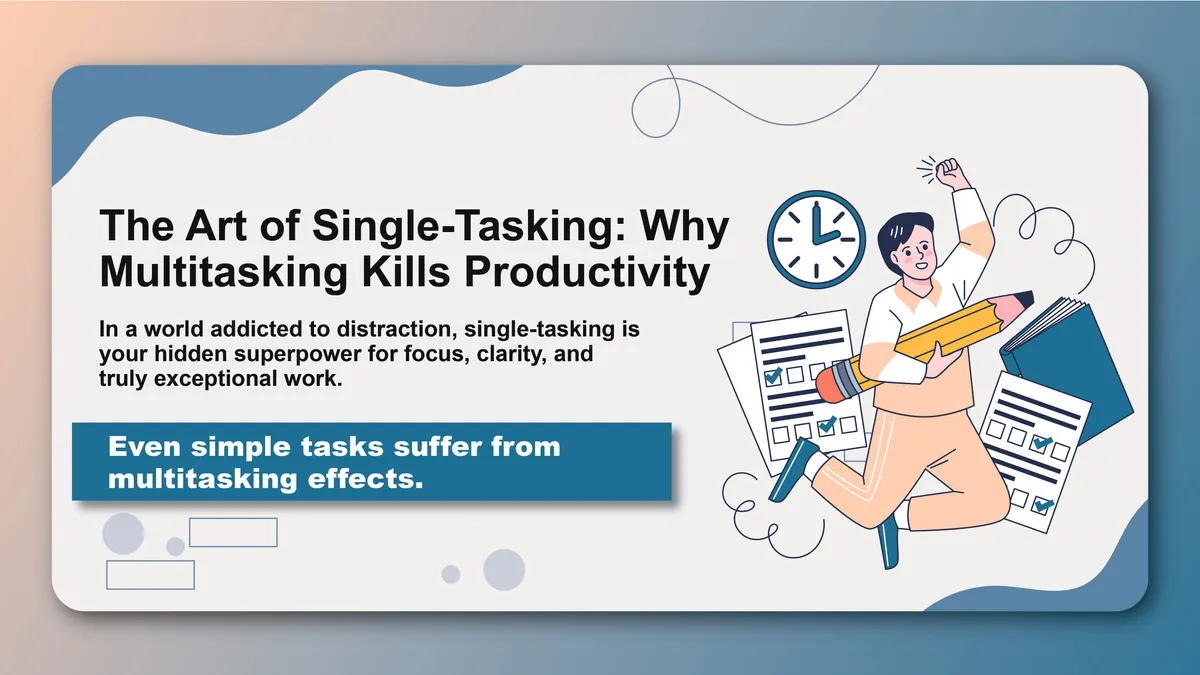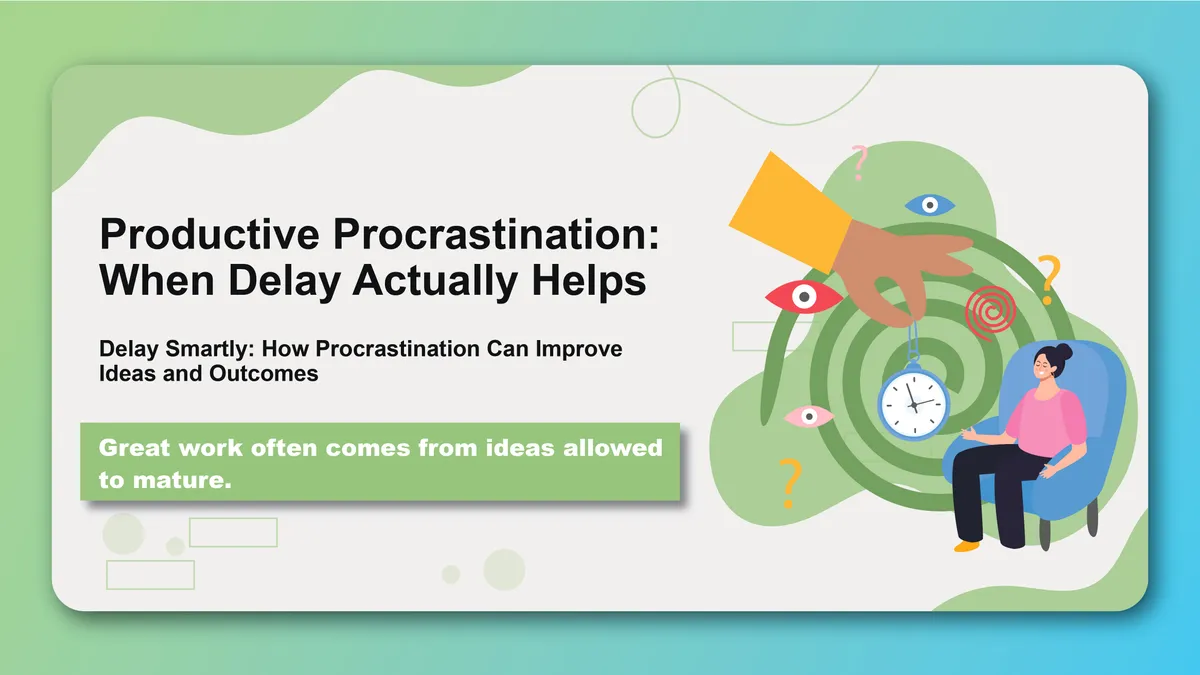In 1987, a university student named Francesco Cirillo was struggling to focus on his studies. He grabbed a tomato-shaped kitchen timer, set it for 10 minutes, and challenged himself to study without distraction until it rang. This simple experiment evolved into one of the most effective productivity techniques ever created: the Pomodoro Technique.
Named after the Italian word for tomato, this method has helped millions of people overcome procrastination, improve focus, and get more done in less time. But what makes it so effective? The answer lies in the science of attention, motivation, and the human brain's natural rhythms.
What Is the Pomodoro Technique?
The Basic Method
The traditional Pomodoro Technique follows a simple structure:
- Choose a task you want to work on
- Set a timer for 25 minutes (one "pomodoro")
- Work on the task with complete focus until the timer rings
- Take a 5-minute break when the timer rings
- Repeat the cycle 3 more times
- Take a longer break (15-30 minutes) after 4 pomodoros
The Six Steps in Detail:
Step 1: Task Selection
- Choose one specific task to focus on
- Write it down to make the commitment concrete
- Estimate how many pomodoros it will take
- Commit to working only on this task during the session
Step 2: Timer Setting
- Use a physical timer, app, or browser tool
- Set it for exactly 25 minutes
- Place the timer where you can see it
- Start the timer and begin working immediately
Step 3: Focused Work
- Work with complete dedication on your chosen task
- Ignore all distractions and interruptions
- Don't check email, social media, or other tasks
- If you finish early, use remaining time to review or improve your work
Step 4: Short Break
- Stop working immediately when the timer rings
- Take a 5-minute break away from your workspace
- Do something completely different: stretch, walk, breathe
- Don't check your phone or engage with work-related content
Step 5: Repeat Cycle
- Start the next pomodoro immediately after your break
- Continue with the same task or move to the next priority
- Maintain the rhythm of focused work and regular breaks
- Track your completed pomodoros
Step 6: Long Break
- After 4 pomodoros, take a longer break (15-30 minutes)
- Completely disconnect from work
- Do something rejuvenating: eat, socialize, exercise
- Return refreshed for the next set of pomodoros
The Science Behind Pomodoro's Effectiveness
Attention and Focus Research
Sustained Attention Limits: Research by Dr. Russell Poldrack at Stanford shows that human attention naturally fluctuates every 10-20 minutes. The 25-minute pomodoro length optimally leverages these attention cycles.
Cognitive Load Theory: Studies indicate that our working memory can only handle 4-7 pieces of information simultaneously. The Pomodoro Technique reduces cognitive load by focusing on one task at a time.
Flow State Facilitation: Dr. Mihaly Csikszentmihalyi's research on flow states shows that focused, time-bounded activities are more likely to produce deep engagement and optimal performance.
Neurological Benefits
Dopamine and Reward Systems: Completing each 25-minute session provides a small dopamine hit, reinforcing the behavior and maintaining motivation throughout longer work sessions.
Default Mode Network: The regular breaks allow your brain's default mode network to activate, which is crucial for creative insights and problem-solving.
Stress Reduction: Time-boxing reduces the anxiety of open-ended tasks by providing clear start and stop points.
Psychological Mechanisms
Temporal Landmarks: Research shows that clear time boundaries help people mentally organize their work and maintain motivation.
Commitment and Consistency: The act of setting a timer creates a public commitment to yourself, leveraging the psychological principle of consistency.
Micro-Deadlines: Short deadlines create positive pressure that can enhance performance without overwhelming stress.
Advanced Pomodoro Techniques
Customized Time Intervals
The 90-Minute Ultradian Rhythm:
- Based on natural biological cycles
- 90 minutes focused work + 20 minutes break
- Better for deep, creative work
- Ideal for complex problem-solving
The 15-Minute Micro-Pomodoro:
- For tasks requiring intense concentration
- Useful for people with ADHD or attention challenges
- Good for getting started on difficult tasks
- Helps build momentum
The 50-Minute Academic Pomodoro:
- Matches traditional class periods
- 50 minutes work + 10 minutes break
- Ideal for studying and learning
- Allows for deeper dive into complex topics
Task-Specific Adaptations
Creative Work Pomodoros:
- Longer intervals (45-60 minutes) for flow states
- Flexible break timing to preserve creative momentum
- Focus on idea generation rather than completion
- Allow for natural creative rhythms
Administrative Pomodoros:
- Standard 25-minute intervals work well
- Perfect for email, scheduling, and routine tasks
- Use breaks to reset between different types of admin work
- Batch similar tasks within pomodoros
Learning Pomodoros:
- 25 minutes study + 5 minutes review
- Use breaks for spaced repetition
- Alternate between different subjects
- Include active recall during work sessions
The Pomodoro Planning System
Daily Planning:
- Estimate pomodoros needed for each task
- Plan your day in pomodoro blocks
- Leave buffer pomodoros for unexpected work
- Review and adjust based on actual completion times
Weekly Planning:
- Allocate pomodoros to different projects
- Plan for different types of work (creative, admin, learning)
- Schedule pomodoros during your peak energy times
- Build in flexibility for urgent tasks
Tracking and Analytics:
- Record completed pomodoros by task and project
- Track your peak performance times
- Identify patterns in distraction and focus
- Adjust your schedule based on data
Overcoming Common Pomodoro Challenges
Challenge 1: Frequent Interruptions
Internal Interruptions:
- Keep a distraction list during pomodoros
- Write down thoughts that pop up to address later
- Use the "just one more minute" rule to finish thoughts
- Practice mindfulness to notice and redirect attention
External Interruptions:
- Communicate your pomodoro schedule to colleagues
- Use visual signals (headphones, closed door) to indicate focus time
- Schedule specific times for availability
- Learn to politely defer non-urgent requests
Challenge 2: Tasks Don't Fit 25 Minutes
Large Tasks:
- Break big projects into smaller, pomodoro-sized chunks
- Focus on progress, not completion
- Use multiple pomodoros for complex tasks
- Celebrate incremental progress
Small Tasks:
- Batch multiple small tasks into one pomodoro
- Use remaining time for task review or improvement
- Combine related small tasks
- Use "filler" tasks for incomplete pomodoros
Challenge 3: Resistance to Breaks
The "Flow State" Problem:
- Take breaks even when you don't want to
- Trust that breaks improve overall performance
- Use timer notifications to enforce break discipline
- Remember that sustainable pace beats sprint burnout
Break Quality Issues:
- Completely disconnect from work during breaks
- Avoid social media and email during breaks
- Use breaks for physical movement and mental rest
- Plan enjoyable break activities in advance
Pomodoro Technique Variations
The Flowtime Technique
Structure: Work until natural stopping point + proportional break Benefits: Respects natural flow states while maintaining breaks Best For: Creative and complex cognitive work
Implementation:
- Work for 25+ minutes until natural break point
- Break time = work time ÷ 5 (minimum 5 minutes)
- Track both work time and break time
- Maintain rhythm while respecting flow
The Timeboxing Method
Structure: Fixed time blocks for different types of work Benefits: Better for varied workloads and meeting schedules Best For: Mixed work environments with multiple priorities
Implementation:
- Assign specific time blocks to different task types
- Use pomodoro principles within each block
- Plan transitions between different work types
- Maintain focus within each designated block
The 52-17 Rule
Structure: 52 minutes work + 17 minutes break Benefits: Based on productivity data from high performers Best For: Knowledge workers with flexible schedules
Implementation:
- Work intensely for 52 minutes
- Take substantial 17-minute breaks
- Use breaks for complete mental disconnection
- Limit to 3-4 cycles per day
Digital Tools and Apps
Essential Features to Look For
Timer Functionality:
- Customizable work and break intervals
- Clear audio and visual notifications
- Easy start/stop/reset controls
- Background operation capability
Tracking and Analytics:
- Pomodoro completion tracking
- Task and project categorization
- Time estimation vs. actual time analysis
- Daily and weekly productivity reports
Distraction Management:
- Website and app blocking during work sessions
- Distraction note-taking features
- Focus mode indicators
- Integration with calendar and task management
Popular Pomodoro Apps
Forest: Gamifies focus by growing virtual trees Be Focused: Simple, elegant Mac/iOS timer PomoDone: Integrates with task management tools Toggl Track: Professional time tracking with pomodoro features
Building a Pomodoro Habit
Week 1: Basic Implementation
Goals: Learn the basic rhythm and overcome initial resistance Focus: Consistency over perfection Expectations: Expect difficulty maintaining focus and taking breaks
Daily Practice:
- Start with 2-3 pomodoros per day
- Use standard 25-minute/5-minute intervals
- Focus on completing the full cycle (work + break)
- Track completed pomodoros
Week 2: Refinement
Goals: Identify personal patterns and preferences Focus: Optimizing break activities and work environment Expectations: Improved focus and better break habits
Adjustments:
- Experiment with break activities
- Optimize workspace for minimal distractions
- Adjust timer settings if needed
- Begin tracking task estimation accuracy
Week 3: Integration
Goals: Incorporate pomodoros into regular work routine Focus: Planning and task breakdown Expectations: More natural rhythm and improved productivity
Advanced Practices:
- Plan daily work in pomodoro blocks
- Practice breaking large tasks into pomodoro-sized chunks
- Use pomodoro estimation for project planning
- Experiment with different work types
Week 4: Optimization
Goals: Fine-tune the system for maximum effectiveness Focus: Personal customization and advanced techniques Expectations: Sustainable long-term practice
Mastery Elements:
- Customize intervals based on work type
- Develop personal break routines
- Create distraction management strategies
- Build pomodoro planning into weekly workflow
Measuring Pomodoro Success
Productivity Metrics
Completion Rate: Percentage of planned pomodoros completed Focus Quality: Subjective rating of concentration during work sessions Task Estimation: Accuracy of pomodoro estimates vs. actual time needed Daily Output: Completed tasks and projects per day
Well-being Indicators
Energy Levels: Sustained energy throughout the day Stress Reduction: Decreased anxiety about overwhelming workloads Work-Life Balance: Clearer boundaries between work and rest Job Satisfaction: Increased sense of accomplishment and control
Long-term Benefits
Habit Formation: Development of consistent focus habits Time Awareness: Better understanding of how long tasks actually take Productivity Skills: Improved ability to estimate and plan work Sustainable Performance: Maintained high output without burnout
Advanced Pomodoro Strategies
Team Pomodoros
Collaborative Work: Synchronized pomodoros for team projects Meeting Management: Time-boxed meetings with structured breaks Accountability Partners: Shared pomodoro sessions for motivation Group Flow: Coordinated deep work periods for entire teams
Project-Based Pomodoros
Project Estimation: Breaking entire projects into pomodoro estimates Progress Tracking: Visual representation of project completion Resource Allocation: Distributing pomodoro time across multiple projects Deadline Management: Working backward from deadlines to daily pomodoro requirements
Your Pomodoro Implementation Plan
Phase 1: Foundation (Week 1)
Day 1-2: Learn the basic technique and choose your timer Day 3-4: Practice standard pomodoros with simple tasks Day 5-7: Establish consistent break habits and workspace setup
Phase 2: Development (Week 2)
Week 2: Experiment with different break activities and work environments Focus: Find what works best for your personality and work style Goal: Complete 80% of attempted pomodoros
Phase 3: Integration (Week 3-4)
Week 3: Integrate pomodoro planning into your daily routine Week 4: Customize intervals and develop advanced strategies Goal: Make pomodoros feel natural and sustainable
Phase 4: Mastery (Ongoing)
Monthly: Review and adjust your pomodoro system Quarterly: Analyze productivity data and optimize further Annually: Evolve your practice based on changing work needs
The Pomodoro Technique isn't just about managing time—it's about managing attention, energy, and mental resources. By working with your brain's natural rhythms and limitations, you can achieve more while feeling less stressed and overwhelmed.
Start simple, stay consistent, and trust the process. Your 25-minute tomato timer might just be the key to unlocking your most productive self.
Ready to master your focus and boost productivity? Track your pomodoros and build better work habits with Habityzer and discover how time-boxing can transform your daily routine.



